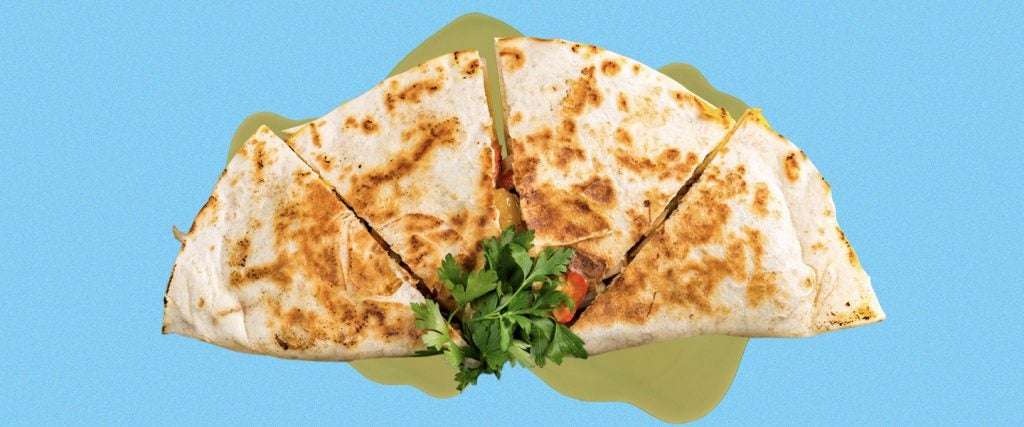Quesadillas are so delicious that even Napoleon Dynamite’s grandmother knew them to be a satisfactory culinary salve for the mood of an argumentative teenage boy.
In terms of its ingredients, a quesadilla is really just two things (or at least that’s all it needs to be): a corn or flour tortilla and cheese. However, you can’t really make such simplicity appear attractive when it’s placed amongst the rest of the offerings on a Chipotle menu. And so, in addition to that tortilla and cheese, Chipotle permits you to choose up to two of its eight “proteins” for inclusion inside of its quesadilla — pollo asado, chicken, carnitas, steak, barbacoa, sofritas, cheese (with guacamole) and fajita veggies (also with guacamole). Apparently on Chipotle’s menu, “fajita veggies” count as a protein.
If we select a standard protein like chicken, and toss it in with the essential ingredients of the quesadilla, how will we fare on the nutritional side?
How about a diet-smashing 830 calories.
Where on earth are all of these calories coming from?
Well, we wouldn’t be ourselves if we didn’t provide you with at least a miniature breakdown of the ingredients, so you can take a look for yourself:
- Flour Tortilla: Wheat flour, water, canola oil, salt and yeast
- Monterey Jack Cheese: Cheese cultures, milk, salt and vegetable rennet
- Chicken: Black pepper, chicken, chipotle chili, cumin, distilled vinegar, garlic, oregano, salt, sunflower oil and water
Honestly, it all looks rather innocuous. Even more perplexing is the fact that the chicken only contributes 180 calories to the mixture. This means that the tortilla and cheese alone are good for 650 calories before we even speculate about what the late-additions might be contributing to the nutrient levels. Also, even with the presence of a lean meat like chicken, the quesadilla still approaches our daily ceiling for saturated fat at 18.5 grams, or 93 percent of the daily recommendation for most people. It also has more than 62 percent your daily sodium allotment, so you’ll want to be cautious about downing too many of these on a regular basis.
Please bear this in mind, too: Chipotle offers you three sides with their quesadilla, and selecting three rational sides — rice, beans and salsa, for example — will push you to the point where you’ve also downed 50 percent of the recommended caloric intake of the average man, and well past the advised point for the average woman.
So, can the quesadilla ever be healthy?
The responsible answer would be to say that the health level of your quesadilla is going to be partially dependent upon whether or not you’re making the quesadilla yourself. However, my gut answer is, “Not really.”
When a food item is defined by its shape, its texture and the massive amounts of gooey melted cheese that cement its folded sides together, that implies that there’s a distinct difference between an authentic quesadilla matching that description, in comparison to a soft tortilla shell with some cheese sprinkled into it. It’s the same way that chocolate coffee with a teaspoon of sugar and a dash of milk is vastly different from a Starbucks Java Chip Frappucino. The core ingredients are the same, but the expectations are very different when you know you’re ordering the sweetest drink on the menu.
To that end, a proper quesadilla is defined by ample portions of two food items — tortillas and cheese — that dole out plenty of calories even in small doses. You can’t avoid it, so just go with it, and as Napoleon Dynamite’s grandmother would say, “Make yourself a dang quesadilla!”

